|
|
|
|||
|
|
||||
|
|
||||
| Smoke Trails | ||||
|
|
HOME | SITE MAP | FORUM | CONTACT |
|
||
|
ABOUT | MOTORS | MODELS | ARCHIVE | HISTORY | STORE | FAQ | LINKS
|
|
|
|
|
|
||||||||||||||||||||||||||||||||||||||||||||||||||||||||||||||||||||||||||||||||||||||||||||||||||||||||||||||||||||||||||||||||||||||||
|
Smoke Trails 13
(December 2007)
by Roger Simmonds Originally published in SAM 35 Speaks, December 2007 First, the compliments of the season to both my readers, and a profound wish for 2008: may the flying weather equal that of the final meetings of this year. Since my last article in SAM Speaks, I have garnered quite a lot of interesting stuff from various sources that I feel duty bound to share with fellow enthusiasts. So this is the first, but hopefully not the last, instalment of a new series of Smoke Trails. The most prolific source of these ‘obscure references’ (to quote the editor in May’s SAM Speaks) has been the internet, where, inevitably, and for good or ill, most of the action seems to be these days. |
|
||||||||||||||||||||||||||||||||||||||||||||||||||||||||||||||||||||||||||||||||||||||||||||||||||||||||||||||||||||||||||||||||||||||||
|
But there will always be a need for pen and paper and printed journals like SAM Speaks, as websites are open to attack and corruption, and a wealth of data can be lost ‘just like that’. Our beloved Jetex.org site was attacked again in September. Though the archives are still accessible, the Forum is inactive and I fear a lot of its accumulated wit and wisdom, not to say the enthusiasm of its members, will be lost forever. That’s progress for you — a warning to us all. So, for me, it’s back to good old ‘hard copy’, where, whilst moth and rust can decay, the accursed ‘hacker’ cannot destroy. Now, where is my quill pen and Esaki parchment? John O’Donnell (‘Letters’, SAM Speaks, September), rightly upbraids me for confusing the ‘Jetex’ and ‘ICI Challenge’ trophies in Smoke Trails 11. However, as John and I now agree following an exchange of emails, both were actually provided by Wilmot Mansour, so my point still stands. If John wants to see examples of modern Rapier-powered free-flight duration designs to be enamoured of, I’m afraid he will have to go to the ‘glossies’ or the internet. For example, Larry Kruse’s Heat Stroke (right) featured in Flying Models, March 2007 (thanks to Dave Day for showing me this one) and a fine video of Steve Bage’s Scorpio can be found on YouTube. But SAM Speaks is hardly the place to discuss these sophisticated modern designs. |

- Flying Models, March 2007
|
||||||||||||||||||||||||||||||||||||||||||||||||||||||||||||||||||||||||||||||||||||||||||||||||||||||||||||||||||||||||||||||||||||||||
|
|
|
||||
Of more interest to us reactionaries are websites like the one dedicated to Howard Boys, being put together by his son Jim Boys. As a preview, here are two illustrations from a French aeromodelling magazine pertaining to Howard Boys’ demonstrations in France just after WWII, where model (and full-size) rocketry was very popular. The Flaming Ptero obviously made a big impression, and Jim still has his father’s French medallion of 1946 to prove it. Incidentally, there are the beginnings of a biography of Howard Boys in Wikipedia.
|
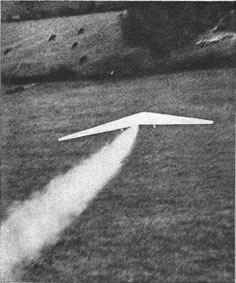
- Je cherche, Nov. 1946 (p. 164)
The remarkable Delfin, similar in appearance to the earlier Swedish Semo products. The full-size L-29 Delfín (‘Dolphin’ in Czech) was Czechoslovakia's first locally designed and built jet, becoming the standard trainer for the Warsaw Pact in the 1960s. |
||||

As well as specialist websites, eBay is well worth keeping an eye on. Vintage Jetex motors and kits still come up regularly, and the prices are now more realistic. I’m still looking for a Velojet, a forlorn hope, one would surmise, but then Andy Blackwell spotted something as unusual and desirable to the über-collector — a profile model powered by a Synjet. Andy was outbid on this occasion, but not before he downloaded these tantalising images (right). As it was made in the Czech Republic some years ago, little is known about the about the Synjet (at least by English speakers). The motor was similar to the Jetex 50, but about the composition of the fuel we know nothing. Fortunately, all this activity on the web jogged John Miller Crawford’s memory of an article published in a Czech modelling magazine Terry Kidd gave him some time ago. This has now been passed to Ruja Zdravi, (who flies Rapiers) for translation. I hope to share the results of his endeavours with readers in due course. |
|
  The extensively prefabricated Delphin came complete with a Synjet, pellets and accessories. |
|||
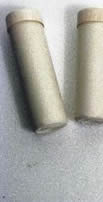
|
|
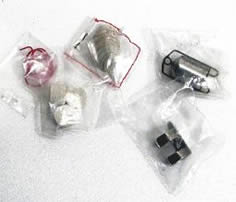
- eBay vendor, 2007
|
|||
|
Old-fashioned research, by which I mean going to swapmeeets and trolling second-hand bookshops is, of course, by no means to be disdained and can lead to serendipitous discoveries, as the following tale attests: |
|
||||

I unearthed a large and rather dull book about model aircraft, published in 1968, in the bowels of a vast second-hand bookshop in Gloucester.The illustration (right) appeared in an otherwise unremarkable chapter devoted to Jetex propulsion. It confirms the model was indeed a Vampire powered by an internally mounted Jetex 100, and very nice it looks too — this model is not the later, and quite inferior, free flight Vampire for Jetex 50 that Wilmot Mansour produced in 1950. Joe Mansour, like our late lamented Stan Pearson, obviously didn’t approve of ‘jet planes with stringers’! The book is more of a ‘coffee table’ publication than a serious history of model aircraft; the text says nothing about the model or who the youngster was. Hopefully, the photo will jog some reader’s memory. A plan would be nice too. This year’s weather redeemed itself with some splendid flying conditions at Middle Wallop and Old Warden in late August and September, where the word ‘halcyon’ springs to mind. Both saw plenty of Rapier, and some genuine Jetex, action. It was good to see a clutch of new fliers, most of whom eventually got their models to fly — for some at a cost of, I would guess, about twenty quid per flight. Rocket fliers need to be a determined bunch blessed with a fair amount of cussedness, but I sometimes wish the reams of good advice others and I have written was taken more note of! The Avro 707 is, for example, a notoriously tricky subject and not a good choice of first scale model, as the elevon settings in relation to motor power need to be ‘just so’. |
|

- The World of Model Aircraft'
(Guy R Williams, Andre Deutsch, 1973) |
|||
|
Russ Lister’s beautifully built Arado E.381 (right) is also an ambitious choice. Russ comments, “The vulnerability of the wings had a great impact [!] on my attempts to fly the model — they seem to get knocked off a little too easily. […] The model is over 30g and a little heavy for standard L2s (I had no HPs) so all even the good flights were low-level affairs with the model sinking to the ground once the power begun to fade. I like the model, but I wish the flying performance had been a little better. I’m tempted to make another one as a few improvements, particularly with regards to weight and the wing mounting it could make a difference.” Quite so. There were several new examples of Aerographic’s Flitzer and Bell XS-1 on the field. These flew well, but like Russ’s Arado, the straight wings of the Bell XS-1 are rather vulnerable. This is a pity, as it is an excellent introduction to rocket flying for the more experienced modeller. Steve Bage suggests that the fuselage could be modified so that the wings are a simple ‘push fit’. |
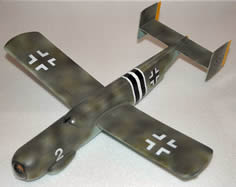
- Russ Lister
|
||||

There were also plenty of profile and semi-profile models around. Of the latter, Andy’s ‘Mach-Box’ (right) wafted around the field most reliably. Being built of |
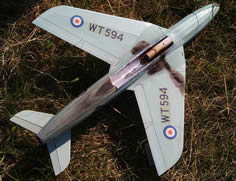 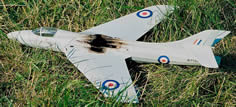
- Roger Simmonds

- Roger Simmonds
|
||||
 |
|||||
|
I was pleased to see two Min-O-Jets at Old Warden (on reflection, this must have been at the wet and windy SAM Gala, not the later one in September), built by Keith Beckett and Brian Thompson. An exemplary choice of first or second model, one would have thought. But, at least initially, the Min-O-Jet appeared directionally unstable and just didn’t seem to want to settle into a predictable flight pattern. Perhaps it missed the weight of the Jetex 50 Phil Smith designed it for, or is capriciousness a feature of butterfly tails? Or perhaps, like another new flier’s KK Cub, which eventually did fly splendidly, it needed a Rapier of lower power (110mN or less) to sort it out. These are difficult to find at the moment. However, Keith is not discouraged, writing, “Although it was quite blustery on the day both of them flew successfully on Rapier L2s and gave us a lot of fun before mine snapped at the boom. Both were built straight off the plan, but make sure the weight box is built in or you it will end up with a lot of unsightly Blu-Tack on the nose. The wing is prone to warp during covering but with a little care it can be done. In summary it is a nice, easy-build fun model”. Copies of the plan are readily available (see the reduced size copy below) — it would be good to see Min-O-Jets competing with Skyjets next year! |
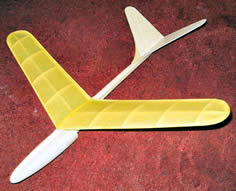
- Keith Beckett
|
||||
 |
|||||
|
And so to some real Jetex action, provided by Andy Blackwell, who had brought along a large Skyleada Skyray (right) and a smaller OD Skyrocket. The Skyray, designed for the Jetex 100, has a nice light design (Andy built it without modification) and a good reputation. For its first flights Andy tried a selection of vintage motors and ICI propellant. The pellets lit reliably enough, but the Jetex 100 at best provided only sufficient power for an extended glide. This was encouraging in that the trim appeared spot on, but Andy wanted better and tried a PAA Loader with Sebel fuel. This provided sufficient thrust for several extended flights over Old Warden — real show stoppers they were — demonstrating there really is nothing like a real Jetex flight after all. Curiously, given that the size of the model meant we could follow it right to the ground, the Skyray proved difficult to find after its last flight … most odd … all joined in the search … it was then realised that it had immolated itself after landing. The remains were difficult to see, as all that was left in the (thankfully only singed) grass was the motor, trough, a bit of Blu-Tack and a melted canopy (right). In the somewhat desultory discussion that followed the Skyray’s apotheosis it was agreed: 1. The PAA Loader, being larger than the Jetex 100 the model was designed for, was too close (about Still, Andy was well pleased with showing us how it’s done, and will build another. This time, I trust, with adequate insulation. We had every expectation that Andy’s novel Skyrocket (right), which is based on Richard Crossley’s design, but has an internally mounted motor, would also fly splendidly. Test glides were straight and true. However, it appeared, like the Skyray, to need rather more impetus than a vintage motor (this time a 50B) could provide. Andy bravely fired up a hotter Jetex 50C. This time, in the evening calm, it made a wide circuit at head height to a nice landing. Much applause — then someone quipped, sotto voce, “Isn’t supposed to burst into flames?”. Reflecting on Andy’s experience, I’m not sure that Jetex fuel doesn’t deteriorate. Though guanidine nitrate is quite stable, the mixture also contains a few percent of quite potent chemicals like dinitro resorcinol, which does degrade. I wonder if the Skyray would have cruised around in quite that stately fashion if the PAA-Loader was providing its specified thrust of 2-2½ oz (700mN). Perhaps I can persuade Andy to do some simple Dr Zigmund-like measurements. And so to the building board. There are now numerous sources of jet plans on the internet from Jetex.org and others; as to kits, Fred Steer of Potty Productions has ‘short kits’ for, amongst others, the KK Spacejet and Jetwing. Replikits are still available from the (rather fussy) Green Air Designs website. The KK Sea Vixen purports to be their latest offering, but the long-awaited Skyleada Hunter and Swift have yet to materialise. Replikits are now laser cut; rather a pity, as it takes away some of the fun and makes modification more difficult. My advice is therefore to look out for the old ones, which had printwood, at swapmeeets and the like (or even on eBay) and snap them up — I don’t think they’ll be back. Serendipitously, John Hook passed me an old Replikit KK Fiat G.80. This one is quite rare — I hadn’t seen an example as a KK plan or kit, or at the flying field — so I did not hesitate. I don’t know what it will fly like, but it is one of Albert Hatfull’s most attractive Jetex designs (below). Curiously, the instructions are in English and Italian. Does anyone know why? |
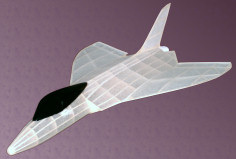 
- Andy Blackwell

- Russ Lister
 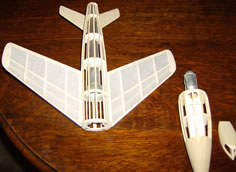
- Andy Blackwell
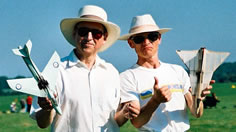
- Ruth Simmonds
|
||||
 |
|||||
|
|
|||||
|
|
|
||||
|
|
|
|
|
|
|
|
Acknowledgements - Article: Roger Simmonds - Illustrations: Roger Simmonds, Keith Beckett, Andy Blackwell, Jim Boys, Russ Lister, Flying Models |
|
|
|
|
ABOUT | MOTORS | MODELS | ARCHIVE | HISTORY | STORE | FAQ | LINKS |
|
|
Terms of Use
|
Queries? Corrections? Additions?
Please
contact us.
|
|